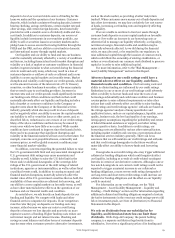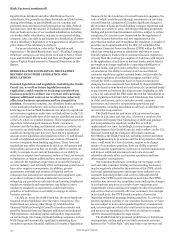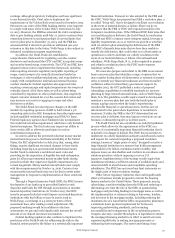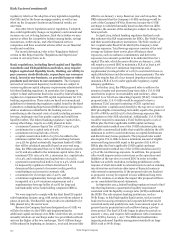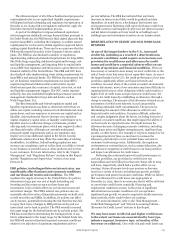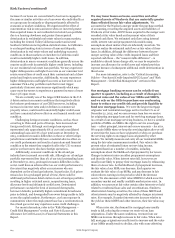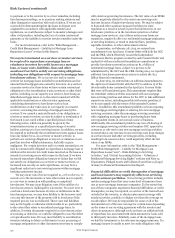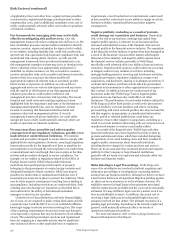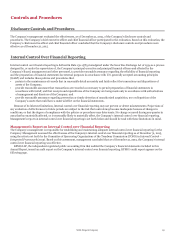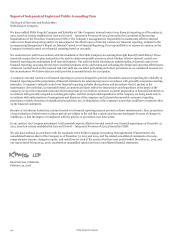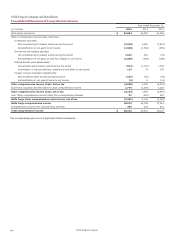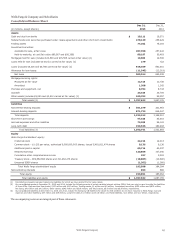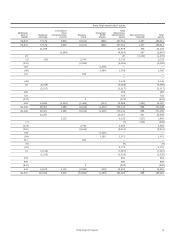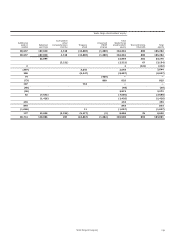Wells Fargo 2015 Annual Report Download - page 131
Download and view the complete annual report
Please find page 131 of the 2015 Wells Fargo annual report below. You can navigate through the pages in the report by either clicking on the pages listed below, or by using the keyword search tool below to find specific information within the annual report.RISKS RELATED TO OUR INDUSTRY’S COMPETITIVE
OPERATING ENVIRONMENT
We face significant and increasing competition in the
rapidly evolving financial services industry. We compete
with other financial institutions in a highly competitive industry
that is undergoing significant changes as a result of financial
regulatory reform and increased public scrutiny stemming from
the financial crisis and continued challenging economic
conditions. Our success depends on our ability to develop and
maintain deep and enduring relationships with our customers
based on the quality of our customer service, the wide variety of
products and services that we can offer our customers and the
ability of those products and services to satisfy our customers’
needs, the pricing of our products and services, the extensive
distribution channels available for our customers, our
innovation, and our reputation. Continued or increased
competition in any one or all of these areas may negatively affect
our customer relationships, market share and results of
operations and/or cause us to increase our capital investment in
our businesses in order to remain competitive. In addition, our
ability to reposition or reprice our products and services from
time to time may be limited and could be influenced significantly
by the current economic, regulatory and political environment
for large financial institutions as well as by the actions of our
competitors. Furthermore, any changes in the types of products
and services that we offer our customers and/or the pricing for
those products and services could result in a loss of customer
relationships and market share and could materially adversely
affect our results of operations.
Continued technological advances and the growth of e-
commerce have made it possible for non-depository institutions
to offer products and services that traditionally were banking
products, and for financial institutions and other companies to
provide electronic and internet-based financial solutions,
including electronic payment solutions. We may not respond
effectively to these and other competitive threats from existing
and new competitors and may be forced to sell products at lower
prices, increase our investment in our business to modify or
adapt our existing products and services, and/or develop new
products and services to respond to our customers’ needs. To the
extent we are not successful in developing and introducing new
products and services or responding or adapting to the
competitive landscape or to changes in customer preferences, we
may lose customer relationships and our revenue growth and
results of operations may be materially adversely affected.
Our ability to attract and retain qualified team
members is critical to the success of our business and
failure to do so could adversely affect our business
performance, competitive position and future
prospects. The success of Wells Fargo is heavily dependent on
the talents and efforts of our team members, and in many areas
of our business, including the commercial banking, brokerage,
investment advisory, and capital markets businesses, the
competition for highly qualified personnel is intense. In order to
attract and retain highly qualified team members, we must
provide competitive compensation. As a large financial
institution we may be subject to limitations on compensation by
our regulators that may adversely affect our ability to attract and
retain these qualified team members. Some of our competitors
may not be subject to these same compensation limitations,
which may further negatively affect our ability to attract and
retain highly qualified team members.
RISKS RELATED TO OUR FINANCIAL STATEMENTS
Changes in accounting policies or accounting
standards, and changes in how accounting standards
are interpreted or applied, could materially affect how
we report our financial results and condition. Our
accounting policies are fundamental to determining and
understanding our financial results and condition. As described
below, some of these policies require use of estimates and
assumptions that may affect the value of our assets or liabilities
and financial results. Any changes in our accounting policies
could materially affect our financial statements.
From time to time the FASB and the SEC change the
financial accounting and reporting standards that govern the
preparation of our external financial statements. For example, in
Proposed Accounting Standards Update, Financial Instruments-
Credit Losses (Subtopic 825-15), FASB has proposed replacing
the current “incurred loss” model for the allowance for credit
losses with an “expected loss” model referred to as the Current
Expected Credit Loss model, or CECL. If adopted, CECL could
materially affect how we determine our allowance and report our
financial results and condition.
In addition, accounting standard setters and those who
interpret the accounting standards (such as the FASB, SEC,
banking regulators and our outside auditors) may change or
even reverse their previous interpretations or positions on how
these standards should be applied. Changes in financial
accounting and reporting standards and changes in current
interpretations may be beyond our control, can be hard to
predict and could materially affect how we report our financial
results and condition. We may be required to apply a new or
revised standard retroactively or apply an existing standard
differently, also retroactively, in each case potentially resulting
in our restating prior period financial statements in material
amounts.
Our financial statements are based in part on
assumptions and estimates which, if wrong, could
cause unexpected losses in the future, and our financial
statements depend on our internal controls over
financial reporting. Pursuant to U.S. GAAP, we are required
to use certain assumptions and estimates in preparing our
financial statements, including in determining credit loss
reserves, reserves for mortgage repurchases, reserves related to
litigation and the fair value of certain assets and liabilities,
among other items. Several of our accounting policies are critical
because they require management to make difficult, subjective
and complex judgments about matters that are inherently
uncertain and because it is likely that materially different
amounts would be reported under different conditions or using
different assumptions. For a description of these policies, refer
to the “Critical Accounting Policies” section in this Report. If
assumptions or estimates underlying our financial statements
are incorrect, we may experience material losses.
Certain of our financial instruments, including trading
assets and liabilities, investment securities, certain loans, MSRs,
private equity investments, structured notes and certain
repurchase and resale agreements, among other items, require a
determination of their fair value in order to prepare our financial
statements. Where quoted market prices are not available, we
may make fair value determinations based on internally
developed models or other means which ultimately rely to some
degree on management judgment, and there is no assurance that
our models will capture or appropriately reflect all relevant
inputs required to accurately determine fair value. Some of these
Wells Fargo & Company
129


